

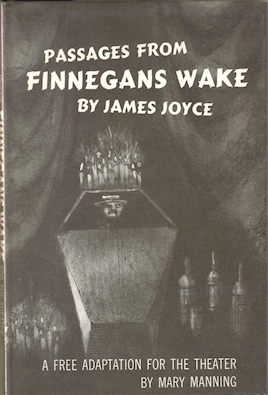
|
[1905-1999]
Passages from Finnegans Wake
|
|
Harvard University Press, Cambridge, 1957. Number three in the Poets' Theatre Series. First Edition. Signed by author.
|
|
from: Penn Sound
Cross-Cultural Poetics
Mary Manning reads from The Wake:
|
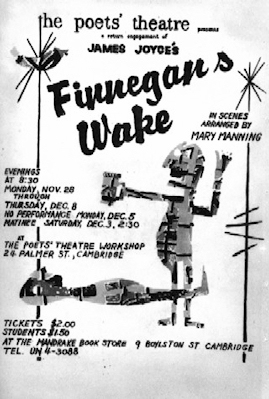
|

Above:
poster from: The Voice Of Shem, 1955 Poets' Theatre, Cambridge from the blog: Libellus Samedi 3 mai 2008
1955 Harvard Crimson review of: Finnegans Wake at the Poets' Theatre |
|
Mary Manning Howe (1905-1999)
Her childhood friend Samuel Beckett contributed a character named Ego Smith to her 1931 play Youth's the Season, which some say helped spark Beckett's interest in writing drama. Her correspondence with Beckett can be found in the new The Letters of Samuel Beckett: Volume 1, 1929-1940 by Cambridge University Press (2009). Mary and her mother Susan Manning were subjected to caricature in Beckett's Dreams of Fair to Middling Women as 'the Fricas' (i.e. 'harpies'), but her lifelong friendship with Beckett survived the rough depiction. For a discussion of the Mannings as the Fricas see Chris Ackerly's LASSATASED: Samuel Beckett's Portraits of his Fair to Middling Women. We've provided some selections from other internet sources about Mary Manning. Early on she edited the Gate's drama journal The Motley and continued writing drama criticism for decades thereafter. She also participated in Ireland's early film societies, and directed and acted in Irish films in the 1930's. We've provided links to Trinity College's Irish Film & TV Research Online, which includes a filmography and occasional samples of her film criticism, and provided some notes about her film work below. After moving to Boston, she headed the Idler Theatre at Radcliffe and founded the famed Poets' Theatre in Cambridge. The list of early Poets' Theatre participants is striking--Frank O'Hara, John Ashbery, Edward Gorey, W.S. Merwin, V.R. Lang, Gregory Corso, Samuel Beckett, comprise just a partial list of the poets and artists involved with Poets' Theatre readings and productions. Richard Wilbur on Moliere, Richard Eberhart, readings by Ted Hughes, Sylvia Plath and Dylan Thomas--an almost unending list of major poetical figures of the Twentieth Century. Alfonso Ossorio designed sets and costumes for performances of Greek Drama and for T.S. Eliot's Murder in the Cathedral. Published memoirs of the early Poets' Theatre can be found in Alison Lurie's V. R. Lang: Poems & Plays with A Memoir by Alison Lurie (Random House, 1975), Nora Sayre's Previous Convictions: A Journey Through the 1950s (Rutgers, 1995), and Peter Davison's The Fading Smile: Poets in Boston, from Robert Frost to Robert Lowell to Sylvia Plath (Knopf 1994). A selection of internet memoirs & biographical entries on Mary Manning are listed below, including excerpts from works by her daughters, Susan Howe and Fanny Howe. For further information on The Poets' Theatre see also The Poets' Theatre page by Andreas Teuber.
Note on the Variations in Spelling and Punctuation:
In the quotations below you'll find many variations on the punctuation and spelling of the original Harvard/Cambridge Poets' Theatre. The Harvard theatre refers to multiple Poets, and uses the British English spelling for 'theatre'.
There are also variations on the spelling of 'Theatre' in general--such as 'Abbey Theatre' versus 'Abbey Theater'. As much of the work below is cited from various web sources, we've left the quoted material intact. The proper spellings can be confirmed and referenced through original websites such as the
Abbey Theatre and the Gate Theatre.
|
|
from the Cambridge Women's Heritage Project:
Novelist and Playwright (b. 1905 in Dublin, Ireland, d. Cambridge MA, June 25 1999) Born in Ireland, Mary Manning went to London to study theater when she was 16 years old. After returning to Ireland, she worked as an actress and playwright in the 1920s and 1930s at the renowned Abbey Theater and the Gate Theater in Dublin and wrote film criticism for the Irish Statesman. Two of her plays were produced at the Abbey Theater and she worked collaboratively on several projects with the playwright, Samuel Beckett who had been her childhood friend. In 1935, she emigrated to Boston and married Mark De Wolfe Howe, a lawyer who became a professor at Harvard Law School. Her three daughters were raised in Cambridge. While in Cambridge, Mary Manning Howe wrote the novel, Mount Venus (1938), and was the drama director at Radcliffe College during World War II. She helped found the Poet�s Theater in Cambridge, which produced some of Yeats� early plays and produced work by new playwrights in the 1950s. After the death of her husband in 1967, she returned to Dublin as theater critic for The Irish Times. In 1980, she returned to Cambridge and married her lawyer, Faneuil Adams.
|
|
|
The original Abbey Theatre
|
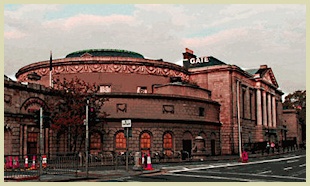
The Gate Theatre
|
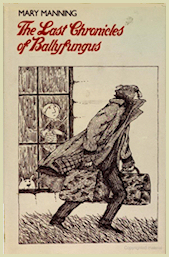
|
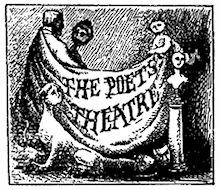
ABOVE: Poets' Theatre logo designed
LEFT: The Last Chronicles of Ballyfungus
|
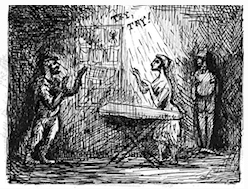
Edward Gorey set design for Try!Try! by
|
| Her writings include the novel The Last Chronicles of Ballyfungus (1978), a humorous view of the Anglo-Irish gentry, and the play, Go Lovely Rose, based on the life of Rose Kennedy, produced as a one woman show at the Fourth International Women Playwright�s Conference held in Galway shortly before her death at the age of 93. One daughter, Susan Howe (born in 1937), went on to become a well-known poet and professor at State University of New York, Buffalo and another daughter Fanny Howe, became a novelist and poet, teaching creative writing at MIT and Tufts and at University of California, San Diego, publishing novels that depicted the Cambridge and Boston area in the 1970s. | |
|
References: Boston Globe 6-27-99; New York Times 6-27-1999; Samuel Beckett Collection, University of Texas, Austin; Susan Howe collection, Geisel Library, University of California, San Diego.
http://www.cambridgema.gov/cwhp/bios_a.html
|
|
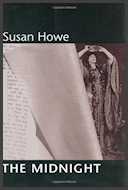
|
Susan Howe's
examination of her mother's spirit and influence from The Midnight and from
Frame Structures:
|
|
|
...my mother brought me up on Yeats as if he were Mother Goose. Even before I could read, �Down by the Sally Gardens� was a lullaby, and a framed broadside �He wishes for the cloths of heaven� printed at the Cuala Press hung over my bed. I hope her homesickness, leaving Dublin for Boston in 1935, then moving on to Buffalo where we lived between 1938 and 1941, then back to Cambridge, Massachusetts, was partially assuaged by the Yeats brothers. She hung Jack�s illustrations and prints on the walls of any house or apartment we moved to as if they were windows. [p. 74]
I can't remember the first play she directed but I remember the Agassiz Theater and how frivolous the name Idler seemed in wartime most of all the heavy curtain in itself a spectacle whose task it was to open at a certain thought over here mapping the deep area where no stage set was ever permanent actors being one character then another according to movements she blocked out. Actors speaking correctly from memory. Trying to separate and distinguish what is recollection as detached from memory keeping falsity hidden. The smell of make-up the shrouded sets and props. [p.16]
|
||
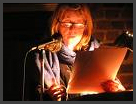
|
Fanny Howe
on her mother,
Mary Manning, and her father, Mark deWolfe Howe |
|
|
from the Poetry Foundation:
http://www.poetryfoundation.org/journal/article.html?id=182585
from
"What I remember of all this is the door through which the FBI undercover agents came one night, and the way my father politely led them in and out of his bookish study. I remember the gaiety of the Poets� Theatre rehearsing in the living room with my mother, and my small, upright father shuttling the men out the door."
"My sister and I loved having our lively young mother at home, with the radio on, playing either the news or music that gave her pleasure and made her stride around with a glass of something strong for a partner. Friends often came over. Our Sunday trips to see our grandfather were special because we were all out in the world together."
|
||
|
A Sample of Mary Manning's Film Criticism
Mary Manning's film criticism is quoted in the digital entry for
Before the release of SMILING IRISH EYES at Dublin's Savoy Cinema on 7 February 1930 cuts were made to it by the exhibitor. Even so, there were complaints by film reviewers and audiences alike about the film's 'stage Irishness', and a demonstration against the film in the cinema four days later forced the cancellation of its run. For an account of the controversy see Rockett et al, 1987:53-5. |
|||
|
|
Production photo and sheet music cover from the film Smiling Irish Eyes.
The film sparked demonstrations
|
||
Evidently she wasn't the only critic that felt that way. A 1929 Motion Picture News article agreed with her assessment:
- 'Colleen Moore at Her Worst', Motion Picture News 27/7/1929:375 Even Miss Moore agreed: 'It was surely the longest, slowest, dullest picture ever made'.
|
|||
|
Mary Manning and
Irish Film and Early Film Societies
http://www.tcd.ie/irishfilm/showfilm.php?fid=56625
Mary Manning acted in the 1930 film By Accident, directed by J.N.G. Davidson.
The film was produced by Irish Amateur Films and screened at the Peacock Theatre. Trinity College's Irish Film & TV Research Online entry for the film includes a synospsis and credits for the film plus the 'Note' below which describes Manning's involvement with the Dublin Film Society and with Irish Amateur Films:
J N G Davidson was a student at St Catherine's College, Cambridge, when the film was made. He later worked at RTE. Blake Clifford and J K Mandy were members of Dublin University (Trinity College) Dramatic Society, while Paul Farrell was an actor at the Gate Theatre.
Irish Amateur Films was probably a name made up for the Peacock Theatre screenings, and has been confused with the Dublin Film Society, which was formed at the end of 1930, to make films and to screen films unavailable in commercial cinemas. The Dublin Film Society unsuccessfully attempted to bring Soviet and other films to Dublin in 1930. Such alternative films to the Anglo-American monopoly of Irish cinema screens were introduced with the establishment of the Irish Film Society in 1936. There was some overlap of membership between Irish Amateur Films and the Dublin Film Society, including Paul Farrell,
Norris Davidson contacted
Though Harold Douglas is recorded as being the film's cameraman in DEM 10/7/1930, according to Davidson, he photographed most of the film, and he reports that Douglas was only slightly involved in the production of the film. Scenes for BY ACCIDENT were shot at Sutton, Co Dublin, the Martello Tower, Howth, on the Feather Bed Mountain, Co Wicklow, and in the Phoenix Park and O'Connell St, Dublin. Interiors were shot at the Abbey Theatre with the aid of P J Carolan. The screenings at the Peacock Theatre were accompanied by a short documentary directed by |
|
Mary Manning, Frank O'Hara, John Ashbery
from the Ashbery Resource Center Archive
|
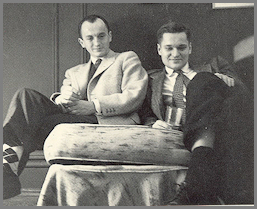
Frank O'Hara and John Ashbery New York, 1953 |
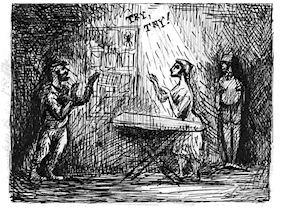
Edward Gorey set design for Try!Try! by Frank O'Hara, a Poets' Theatre production |
|
from the Ashbery Archive entry on Try! Try!:
Ashbery played the role of 'John, a friend of the poet's' in the Poets' Theatre production of Frank O'Hara's play Try! Try!, directed by V.R. Lang [i.e., Bunny Lang] (Cambridge, MA, 1951). The other cast members were Lang in the role of Violet and Jack Rogers in the role of Jack, Violet's husband.
Try! Try! was presented in conjunction with three other plays: Ashbery's Everyman; a Masque, directed by
The ARC has copies of two audio tapes from the Poetry Room of the Harvard College Library: one includes a recording of the performance of Try! Try!; the other includes a recording of the performance of Everyman.
The ARC also has a photocopy of a page from an annotated program for the performances. The annotations to the program are in an unknown hand; they refer to reel-to-reel audio recordings of the 1951 production of Try! Try!. Per David Kermani, Ashbery heard these recordings at the home of Edward Gorey. Enclosed with the program is a copy of 1977-04-10 correspondence from Kermani to Stratis Haviaris, including discussion of the recordings and the program as well as more anecdotal discussion regarding Ashbery's participation in the production of O'Hara's play.
The program for the Poets' Theatre tribute to Frank O'Hara, Frank O'Hara: Read, Performed, Remembered, which took place 1990 April 28-29, includes a reproduction of a pen and ink sketch of a set design by Gorey (p. [23]), as well as historical and anecdotal information regarding O'Hara's place in the Poets' Theatre:
'Frank O'Hara was one of the original members of the Poets' Theatre. Indeed the very first presentation by the Poets' Theatre was a production of four one-act plays, which included a play by O'Hara and starred ''Bunny'' Lang, Jack Rogers, and John Ashbery. Ashbery himself had written a play for the program for which O'Hara composed the music and which was performed under the direction of Mary Manning . Daniel Ellsberg who was then an undergraduate at Harvard reviewed the show, [1951-02-26], for the Harvard Crimson:Teuber also notes that 'Larry Rivers painted a backdrop for the play but O'Hara thought it did not ''fit'' the piece so he re-wrote the play to ''fit'' Rivers' design. This second version was produced a couple of years later at the Artists' Theatre in New York City. Rivers' painting for Try! Try! is in the collection of the Museum of Modern Art. You may search this catalogue for a separate citation for Frank O'Hara's poem 'An Epilogue: To the Players of Try! Try!'.
Try! Try! entry above from: The Ashbery Resource Center Archive http://www.flowchartfoundation.org/arc/home/ Bibliographic code.....J5 Author..... Ashbery, John Title.....'Try! Try!' Publication.....Try! Try! Author/Editor.....O'Hara, Frank (playwright); Lang, V.R. [i.e., Lang, Bunny] (director) Language.....English Place of Publication.....Cambridge, MA Publisher.....Poets' Theatre Publication date.....1951-00-00 Format.....Audio Recording; Program Type.....Performance; Play
|
|
from
Beckett Remembering, Remembering Beckett:
By Samuel Beckett, James Knowlson, Elizabeth Knowlson
|
|
|
|
Mary Manning and Irish Theatre
from:
Modern Irish Theatre
by Mary Trotter
Indeed, Mac Liammoir and Edwards were blessed with very talented collaborators, many of whom were women. They had not one but three leading women actors - Meriel Moore, Betty Sheridan, and Coralie Carmichael. And they also had an actor, playwright, and scholar in Mary Manning. Manning studied at the Abbey School of Acting under Sara Allgood in the 1920's, and acted at both the Abbey and the Gate. She became the founding editor of the Gate's quarterly journal, Motley (joining in the tradition of creating a journal to complement the theatre, started by Yeats with the Irish Literary Theatre), in 1929, and remained editor until she emigrated to the United States in 1935.
It is remarkable that Manning edited a performing arts journal as impressive as Motley while still only in her early twenties. Its contributors included Frank O'Connor, Padraic Colum, Austin Clarke, and Francis Stuart, and it offered ample reviews, photographs, and illustrations of Gate theatre productions. Her 1931 drama (rev. 1933), Youth's the Season — ? a drawing room tragic-comedy in the vein of Noel Coward or Phillip Barry, became an early Gate Theatre hit. Youth's the Season — ? was one of the first plays to show Dublin's upper-class youth, and their quest for meaning amid their materialist lives fraught with family expectations.
Robert Hogan remarked that Manning's 'incisive perception and satiric wit were beautifully evident in Youth's the Season — ? [sic] which still comes near to being the most sophisticated yet poignant study to come out of Dublin' (Hogan 1967a: 9) It also allowed Mac Liammoir and company to have hand at a play of drawing-room sophistication with (upper-crust) Dublin accents. Manning wrote three more plays for the Gate before she emigrated to the USA, where she continued writing, with a focus on novels. Her adaptation of Finnegans Wake, The Voice of Shem (1955), was made into a film in 1966. She returned to Ireland and its theatre scene in the 1960's, and continued writing in England and Ireland until her death in 1999.
|
|
from:
http://www.robertwernick.com/articles/Molly.htm
by Robert Wernick
Though administratively speaking Molly was completely Bostonian - who else of your acquaintances has successively married men named Quincy Howe and Faneuil Adams? - her stories were never of Boston, she never mentioned the Poets Theater which she had helped run for so many years. She wanted to tell stories of Ireland.
Like how she came to her grandmother's house one day after school during the troubles, and on the front steps she found a blood-caked shoe with a blood-caked human foot inside it. And she brought it in with her, and Granny seized it and firmly spoke:"I have said it once and I have said it again and I will say it again now, I will never tolerate any IRA blackguard setting foot inside my house." And she threw the shoe out back into the street where it belonged,.
This war the grandmother who raised roses and loved them and called each of one of them by its official name, and one afternoon fluttered a garden party by suddenly shouting out as she leaned down to peer at some of her new blooms,. "I should never have put General Foyle in the same bed with Madame Ravollie."
Once, when Molly was sixteen and rehearsing for her role as the Faery Child in a school performance of Yeats's The Land of Heart's Desire, she was invited to tea at Maude Gonne's house, where Yeats himself would also be a guest He thought she looked the part perfectly, and was delighted to have the opportunity of showing her how a Faery Child should "run up out of the wind,.her face pale as water before dawn" to make her elfin entrance on stage. He walked back to the door, turned slowly around, and came prancing forward, with his eyes in the stars, and swinging his arms, and he knocked over a large vase of flowers which fell on a tea tray breaking two cups and destroying a chocolate cake. "Willie Willie," wailed Maud Gonne, "You can't move without breaking things." "Maud," replied the poet, "I do not, like you, break hearts."
One afternoon she was at home with her mother when in came Mr. Beckett, who lived up the road from the Mannings [Molly was born Mary Manning, and that is the name under which she published her collection of Irish stories called The Last Chronicles of Ballyfungus which some canny publisher might do well to reissue], came calling and asked Mrs Manning if she would go riding with him in his Packard automobile.
She said Yes, and she took little Molly by the hand and they followed Mr. Beckett out to his car. Mr. and Mrs.Manning too their places on the front seat, little Molly lolled in the capacious back seat, and they took off at a steady authoritative speed maneuvering through the winding streets of Dublin. .
Dublin was not then the minimetropolis it is today, there were very few automobiles on the streets, and certainly no other Packards, the streets were neither well paved not well patrolled, and it took a long time, a long time in utter silence, for Mr.Beckett to thread his way through all the disorderly mass of horse and foot traffic, through the city center, and then over the Liffey and round a circuitous route through the northern suburbs. And all in utter silence save for the gentle throbbing of the Packard motor, a silence which grew deeper and blacker with each turn of direction and each frightened horse and each hooting pedestrian. Till at last they came to a halt in front of an imposing house with a monumental gate and pillars and balconies and a lawn and an orchard and a garden, and Mr. Beckett. sitting upright and clutching his wheel as he had through the whole voyage, said in a measured mournful voice, "My heart lies buried in that house." "Mine too," said Mrs. Manning quietly. Then silence again. Mr. Beckett shifted his gears, and the car started again, and they drove back the way they had come, all the way back to the Manning home without another word being spoken..
For - as was later grudgingly explained to the persistently questioning child --this great house was the home of a Mister Sullivan, a prominent citizen of Dublin. He had a beautiful daughter, and Mr. Beckett in the first flush of his youth was deeply in love with her, and she with him. And he had a handsome son, and Mrs. Manning-to-be was deeply in love with that son, and he with her.
But the Sullivans were Catholics, and marriage with Catholics was of course out of the question for people brought up in respectable families of the Protestant Ascendancy.
There is no record of Mr. Beckett's son Samuel ever being taken in the Packard on such a sad ceremonial voyage to the Sullivan home. But he and Molly were great friends as they grew up together in Dublin, and she must have told him the story, and some of the heavy brooding silence of the Packard may well have nestled in the little boy's soul, to come out half a life time later in the works of the Nobel laureate.
Perhaps the memories go back even further than childhood.
Samuel Beckett is the only person I have known who claimed to have retained memories of life in his mother's womb. He intimated that it was rather an unpleasant place.
I am not sure of the chronology, but it is tempting to speculate that one of these memories goes back to a moment when the pregnant Mrs. Beckett was attending a performance of a one-act play by Lord Dunsany, a very prolific and popular (and by current standards hopelessly mediocre) writer of the early years of the twentieth century.
The play was called Glittering Gates, and it was staged by the Abbey Theater in 1908. Samuel Beckett was born in 1905, but of course Mrs. Beckett may have seen an earlier tryout, or even read the play in manuscript. At all events, the action of the play is set in a desolate place where a couple of desolate creatures, two cockney burglars, drift on to the stage to talk and wait and talk and wait in front of heaven's gates, which they have been led to believe will open to let them in. From the top of the gates there descend periodically bottles of beer, but no other material or spiritual sustenance. They grow increasingly frustrated and despondent as they prattle drearily on while the gates remain as still and silent as ever. Then suddenly there is a sharp grinding noise as the gates begin to open and the two wretched men rush toward them to see what lies beyond. What they see is, in the words of the play's next-to-the-last stage direction, "empty night and stars, to the accompaniment of mocking laughter". Then come two concluding lines of dialogue::
Bill: Stars! Bloomin' great stars! There ain't no heaven, Jim.
Jim: That's very like them. Yes, they'd do that.
And then
[Curtain]
If this connection can be established, do we not have a seed, which with others provided by the Buster Keaton and the Laurel and Hardy movies, flowered into the inalienably absurd credo of the hero, if that is the word, of Beckett's novel, L'Innommable: "Nothing to communicate, no way of communicating, must communicate" not to speak of providing the plot for the play which summed up the world in 1950, Waiting for Godot?.
Molly wrote once to Sam from Boston that, counting out the months on her fingers, it seemed distinctly possible that he was the father of one of her three daughters. The daughters, learning about this in later life, were much intrigued with the idea that one of them might bear the blood of the greatest playwright of the day, and debated which of them was the lucky one. There was no way of solving the debate until the development of DNA testing, and when they produced the necessary blood samples, it turned out that they were all identical, all Howes.
I asked Molly once what had been Sam's response to her bulletin.
Stoical, she said. He said that he would have to work studiously to improve his techniques of contraception.
Irish Writing in the Twentieth Century: A Reader, p. 374 |
